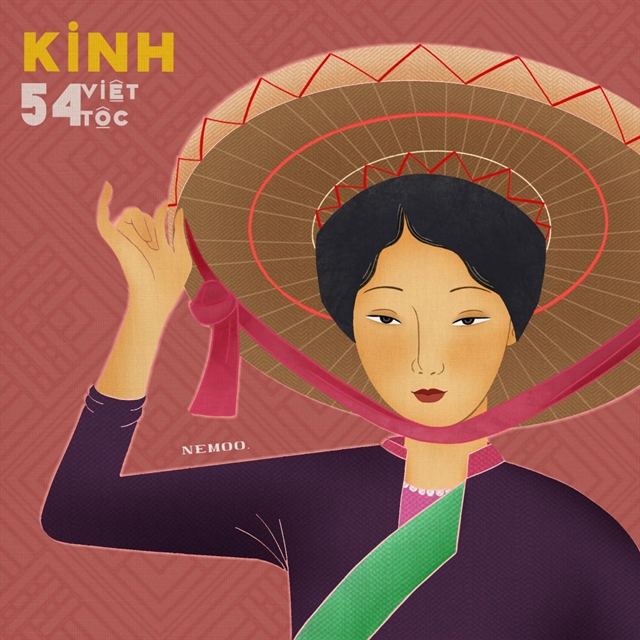 Features
Features

Lê Thu Quỳnh enjoys the beauty of Cát Bà National Park, one of the best protected areas in the country in terms of biodiversity, with the tropical and sub-tropical ecologies common to Asia.
by Lê Thu Quỳnh*
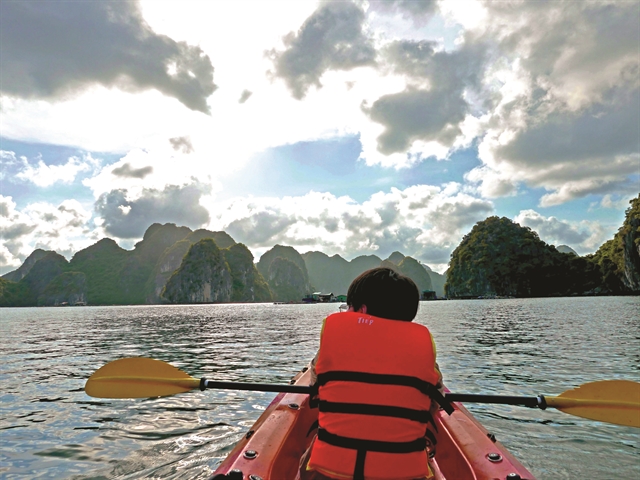
|
| THROUGH A CHILD'S EYES: Ten-year-old Wolf loved Lan Hạ Bay and the 'secret valleys' surrounded by limestone karst mountains. VNS Photo Thu Quỳnh |
Were it not for the pandemic, my daughter Wolf and I would have spent the summer travelling to Beijing, Shanghai, Hangzhou, and Chongqing. But with borders closed, we came up with Plan B: visiting five national parks from Việt Nam’s north to south: Cát Bà and Cúc Phương in the north, Phong Nha and Bạch Mã in the central region, and Nam Cát Tiên in the south.
The return of COVID-19, however, also put a stop to that. But not before we had at least enjoyed the beauty of Cát Bà National Park.
Cát Bà National Park
Every summer we plan to go somewhere, so little Wolf can experience the life, culture, and people of different places and pick up the skills needed to live close to nature.
We embark upon a trip whenever possible, and Wolf’s first was when she was just a few months old.
Spanning more than 150 square kilometres, Cát Bà National Park is one of the best protected areas in the country in terms of biodiversity, with the tropical and sub-tropical ecologies common to Asia. It also has the karst geology typical to the region -- a vast area of rainforest on limestone karst structures, with mangrove forests, large coral reefs, tidal zones, and salt water lakes.
The park has all that’s necessary to become a global geopark: beautiful pristine beaches, unique caves with stalactites and stalagmites, and a diverse biological gene pool. It’s a whole world for nature lovers to explore.
Tours and treks are available, and no entry tickets are required, despite what many people think.
But it is, however, a protected zone, for it contains protected flora and fauna, and you need a ticket to get in.
On Cát Bà Island you can walk from one ecological zone to another within a day. You can move from rainforests on limestone karsts to mangrove forests in mountains (at Ao Ếch). You can also walk from a mangrove forest by the seaside for a swim around coral reefs near the shore. You can then explore caves to search for the home of thousands of bats or take a walk through fields of crops grown in valleys by local farmers.
Such biodiversity makes Cát Bà National Park worth a visit any time of the year.
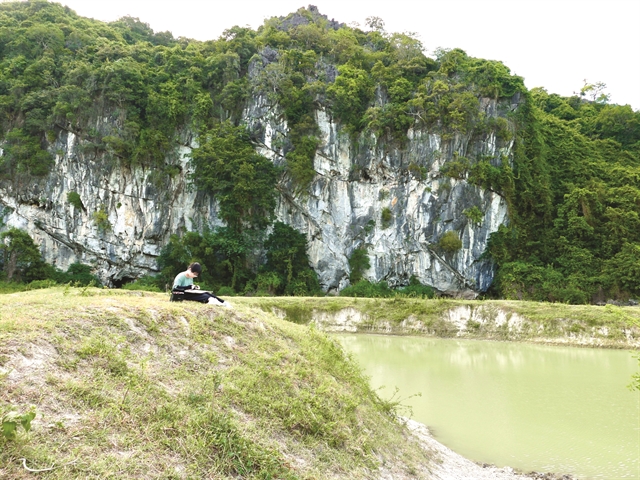
|
| IDYLLIC SURROUNDINGS: The 'butterfly valley' is the best spot to explore nature. VNS Photo Thu Quỳnh |
When little Wolf was six years old, I started to let her do a little web searching to choose where we would stay on our trips. She always looked for somewhere with distinctive features and attractions, and even decided where we would eat.
To avoid busy Cát Bà Town, we stayed in chill bungalows in a pine forest 15km away, which felt like another world.
Each bungalow is hidden under tall pine trees, with dried pine needle making a soft carpet for you to step on. In front of each is a hammock, where you can lie and look up at the sky through the foliage.
The back of our bungalow looked out over a small stream, where it was possible to bathe in the cool water. There was also a little trekking route, for those keen to stretch the legs but wary of the harsh sun.
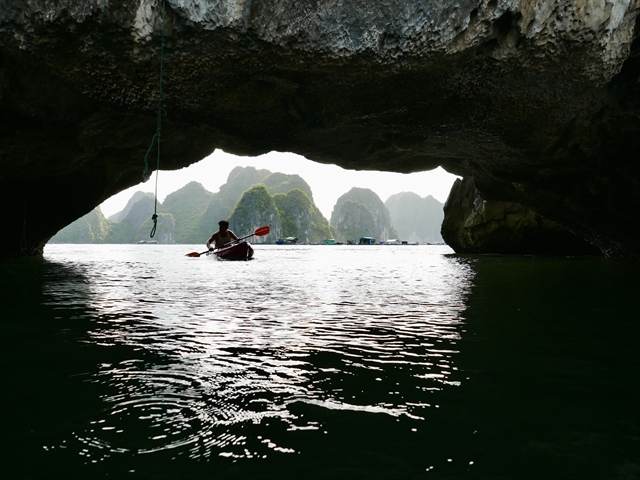
|
| TAKING CARE: Beware of whirlpools when kayaking around 'Three Giant Peaches' on Lan Hạ Bay. VNS Photo Thu Quỳnh |
Green island, white clouds
After some thought, we decided to get around Cát Bà by motorbike, which is the best way of doing so. Though we rode around under the scorching July sun, the sea breeze kept us cool.
Walking up Mt Ngự Lâm turned out to be more challenging than we expected. It was only a kilometre and a half, but there were no steps. It was so steep we had to grab on to rocks to climb. It turned out to be too much for ten-year-old Wolf. The surface was slippery and more dangerous than she or even I could handle. Though she wanted to give it a try, I decided we should turn around.
We stopped at a café shortly after, where the owner told us we had made the right decision. Just a few days prior, a young girl older than Wolf had slipped and ended up in hospital. Needless to say, I felt quite lucky. I always want my child to take on a challenge, but only if it’s actually within her abilities.
Having missed out on the peak of Mt Ngự Lâm, Wolf learned what she could about rare and precious wood trees like lát hoa (Chukrasia tabularis A.Juss), which provides a beautiful finish thanks to its wavy grain. She also learned about ironwood and menghundor, which are just some of the many valuable woods found in tropical jungles.
She had a fun time trying to poke at the bushes. Whenever she touched them, the leaves would slowly fold. When they opened up again, she made them fold again. She also came across a butterfly with quite strange colours.
For those of you who like a bit of a thrill, there’s a peculiar sight in the park -- an abandoned house near the entrance. Park employees used to live there, but they had to move elsewhere out of respect for the protected zone.
Under a rotting roof, all doors and windows had long since been lost and the paint on the walls had faded. It had a vintage yet gloomy feeling, like a haunted house in a ghost story. It would have served well as a background for ghost-themed photos too, but those rotting tiles could literally come crashing down at any time.
Later that day we found ourselves lost in a “butterfly valley”. Located in Liên Minh Commune, the valley was exceptionally tranquil -- a large flat expanse surrounded by tall karst mountains. Thousands of butterflies fly about around noon, creating a beautiful and appealing scene for a curious child like Wolf.
It’s also a popular spot for expats and foreign tourists keen on rock climbing. Wolf also got to see cattle drinking water for the first time, and enjoyed watching buffaloes take a cool bath. If you ever find yourself in Cát Bà, remember to spend a few hours or even an entire afternoon just hanging out in this wonderful valley. It has a distinct vibe and aura not found elsewhere.
Reaching it requires navigating a few steep slopes, which always gets the heart racing. But I’d taken on steeper slopes in the northwestern mountains, so these were quite manageable.
The path leading to the valley starts out in Cát Bà’s main street, stretching for 35km and connecting the town with Cát Hải. We fell in love with the beautiful landscapes we encountered along the way, and came to the conclusion that motorbike is by far the best way to take in everything the island has to offer.
Once in a while, we had a bonus -- giant white clouds fluttering overhead like enormous cotton candy. It felt like heaven!
During our days on Cát Bà we had cloud parties, with white cloud dawns and pink cloud sunsets. We felt like rubbing our heads in these soft bundles of joy and wanted so much to somehow reel one in and keep it. It might seem silly, but we’re not ashamed to say it out loud!
Seas around Cát Bà and Lan Hạ Bay
Cát Bà’s beaches are known for their spectacular white sands, crystal clear waters, and soft waves lapping ashore. But the island has so much more to offer than just lazing on the beach.
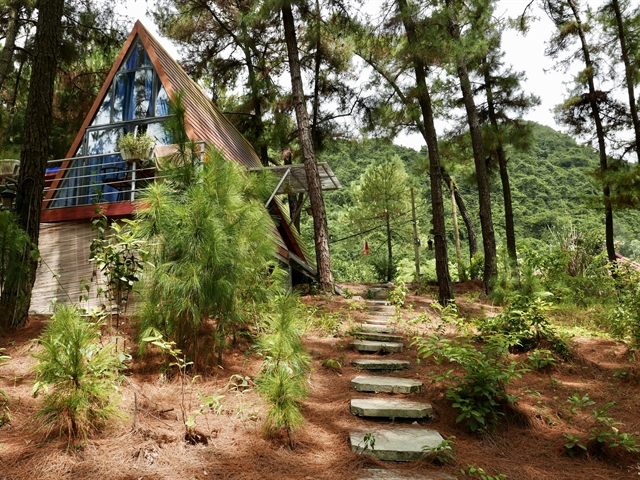
|
| SERENE SPOT: The Cát Bà Ecolodge, where we stayed while exploring the national park. VNS Photo Thu Quỳnh |
We decided to rent a small boat and set sail. The sky was a deep blue at some point, but quickly turned to grey and then became quite dark. The sea began to swell, but retained its beauty.
The waves were making it a rough ride for Wolf. She became tired and a little bit seasick. But the sight of Cái Bèo Village -- one of Việt Nam’s oldest and largest fishing villages and still fit for purpose -- lifted her spirits.
Boats have bobbed up and down in the waters here for, historians say, as long as 7,000 years. Their different colours make Cái Bèo simply beautiful. As our boat approached, it felt as though we were heading towards a 3D image.
Wolf got to see lives different from her own, all happening on the limited space of a boat’s deck. Her jaw dropped at the sight of kids her age swimming like fish or rowing boats with such skill and ease. The kids jumped quickly from one boat to another, each of which seemed to have one or two dogs, who barked cheerfully when the visitors -- Wolf and I -- arrived.
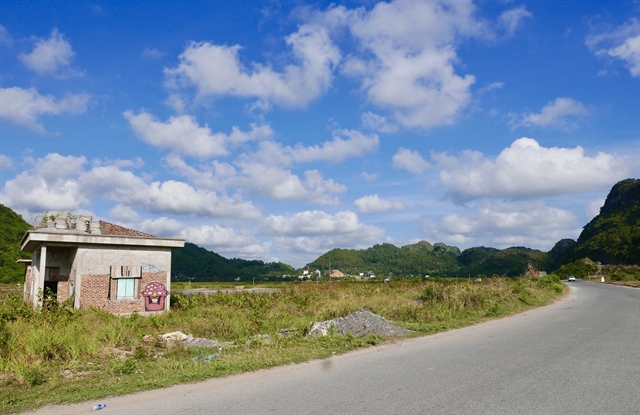
|
| JOURNEYS: 'The long and winding road' always takes you where you wish to go, in this case Cát Bà Town. VNS Photo Thu Quỳnh |
After passing Cái Bèo Village we were in Lan Hạ Bay. The karst islands that dot the bay come in more shapes and sizes than you could possibly imagine and are a true wonder of the world. Nestled on some of the karst islands were small beaches that have remained untouched by tourism all these years.
It’s also heaven for rock climbers and those who like to dive into water from great heights. The most famous rock -- known as the Leaning Tower -- has a steady stream of people climbing up and then plunging into the sea. A group of bungalows nearby house the rock climbers and other adventurous types.
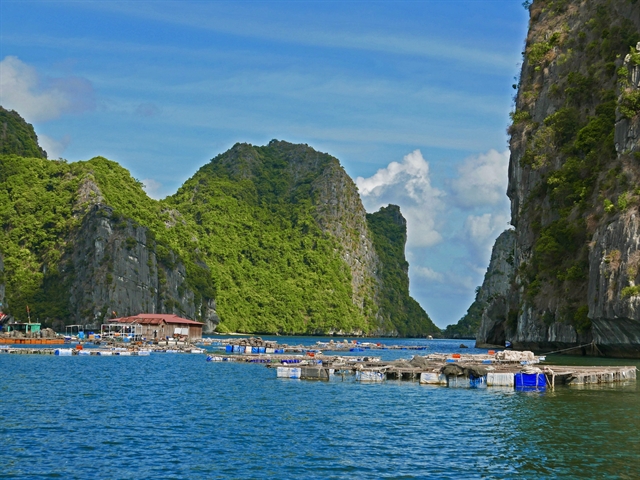
|
| TRIED & TRUE: Cái Bèo fishing village, one of the country's oldest, where you can enjoy giant garupa. VNS Photo Lê Thu Quỳnh |
Some of the karst islands have “secret valleys”, which can only be accessed by passing through caves. When the tide is high, though, grottos can also become submerged, and our destination, Coca rocks, became out of reach. So we rowed into one of these secret valleys instead.
There you can keep rowing or stop and take a break. There was a tree high above in full bloom, its white flowers exuding a sweet fragrance. Wolf fell asleep after the rough boat trip, perhaps dreaming of new destinations to come.
I lay down, contemplating our surroundings. It was like being in a place with no connection at all to the “real world” we occupy every day of our lives. VNS
*Lê Thu Quỳnh is known among the travel community in Việt Nam as Kìn Còi, the influencer




